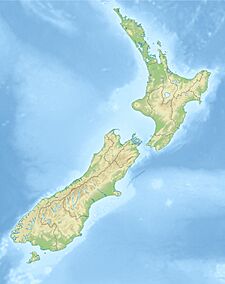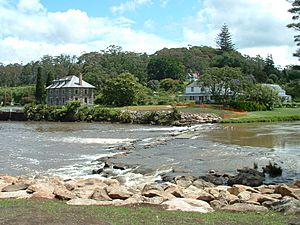Bay of Islands facts for kids
Quick facts for kids Bay of Islands |
|
|---|---|
Urupukapuka Island
|
|
| Location | North Island |
| Coordinates | 35°12′S 174°10′E / 35.200°S 174.167°E |
| Type | Bay |
| Part of | Pacific Ocean |
| Basin countries | New Zealand |
The Bay of Islands is a beautiful area located on the east coast of the Far North District in the North Island of New Zealand. It's one of the most popular places for fishing, sailing, and tourism in the country. It became famous worldwide for its big-game fishing after American author Zane Grey wrote about it in the 1930s. The Bay of Islands is about 60 km (37 mi) north-west of the city of Whangārei.
Contents
Exploring the Bay of Islands' Geography
The Bay of Islands is a natural harbour shaped like a drowned valley, about 16 km (10 mi) wide. It covers an area of about 260 km² (100 sq mi). This amazing bay is home to 144 islands! The biggest island is Urupukapuka.
Main Inlets and Peninsulas
The bay has many peninsulas and inlets, which are like small arms of the sea reaching into the land. The three largest inlets are Waikare Inlet in the south, and Kerikeri and Te Puna (Mangonui) inlets in the north-west. The Purerua Peninsula helps separate the north-western part of the bay from the big Pacific Ocean. Also, the Cape Brett Peninsula stretches 10 km (6 mi) into the ocean at the eastern end of the bay.
Major Towns in the Bay
The biggest town in the area is Kerikeri, followed by Paihia. The small town of Russell is located on a short peninsula that extends into the bay from the south-east.
A Journey Through Bay of Islands History
About 700 years ago, one of the large Māori migration canoes called the Mātaatua sailed to the Bay of Islands from a place called Hawaiki. This journey was led by Puhi, who was an ancestor of the Ngāpuhi iwi (which means tribe). Today, the Ngāpuhi are the largest Māori tribe in New Zealand. Māori people settled and grew in numbers all over the bay and on many of its islands. They formed different tribes, like the Ngāti Miru at Kerikeri. Many important Māori leaders were born in the Bay of Islands, including Hōne Heke. He famously cut down the flagpole at Kororāreka (Russell) several times, which led to a conflict known as the Flagstaff War.
Early Settlements and Their Importance
Many Māori settlements in the Bay of Islands later became very important in New Zealand's history. For example, Okiato was the nation's very first capital city. Waitangi is where the famous Treaty of Waitangi was later signed. Kerikeri was a key place for Māori traveling by sea and later became the site of the first permanent mission station in the country. Some islands also became well-known, like Motu Apo (Te Pahi Island). This island saw a sad event where some of chief Te Pahi's people were harmed because of a misunderstanding, as he was wrongly blamed for something that happened elsewhere.
European Arrival and Early Life
The first European to visit this area was Captain Cook in 1769, and he gave it the name "Bay of Islands." This bay was also the first place in New Zealand where Europeans settled. Whalers started arriving in the late 1700s, and the first missionaries settled in 1814. The first European child known to be born in New Zealand, Thomas King, was born in 1815 at Oihi Bay in the Bay of Islands.
Historic Towns and Buildings
The bay is home to many interesting historic towns, including Paihia, Russell, Waitangi, and Kerikeri. Russell, which used to be called Kororāreka, was the first permanent European settlement in New Zealand, dating back to the early 1800s. Kerikeri has many historic sites from the very first European colonial settlements. These include the Mission House, also known as Kemp House, which is the oldest wooden building still standing in New Zealand. The Stone Store, which used to be a warehouse, is the oldest stone building in New Zealand. Its construction began on April 19, 1832.
Famous Visitors and Events
In the 1800s, the Bay of Islands was visited by ships involved in sealing and whaling. These ships hunted in the ocean around New Zealand and often traded with local Māori tribes for food like potatoes and pork. In December 1835, the famous scientist Charles Darwin visited the Bay of Islands on his ship, the HMS Beagle. In February 1840, some members of the United States Exploring Expedition were present when the first part of the Treaty of Waitangi was signed at Waitangi.
The Historic Cream Trip
In 1886, a man named Albert Ernest Fuller started a sailing ship called the Undine in the Bay of Islands. His goal was to deliver coal to the islands within the bay. Later, in the early 1900s, a motor was added to the ship. This allowed Fuller to deliver coal and other important supplies to communities as far away as Cape Brett.
Delivering Cream and Essential Supplies
In 1927, Fuller took over a service called the Cream Trip from Eddie Lane. This service used ships with special facilities to transport cream from the islands. By the 1960s, a new ship called the Bay Belle started this important route.
Even though a modern catamaran now takes this historical route, the Bay Belle still carries visitors and local people between Paihia and Russell throughout the day. It's a great way to experience a piece of history!
See also
 In Spanish: Bahía de las Islas (Nueva Zelanda) para niños
In Spanish: Bahía de las Islas (Nueva Zelanda) para niños



